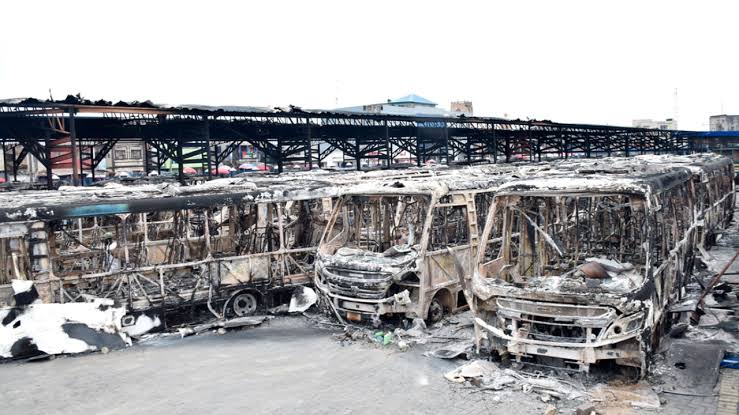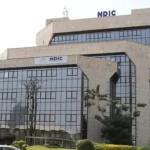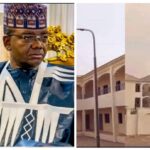By Kenneth Maduagwu
The wheels of Nigeria’s infrastructural development are clogged at every turn. Factors such as insufficient budgetary allocations to corruption impede the country’s capacity to build for its development. As a key driver for sustainable development and lifting millions of people out of poverty, these realities are worse when the country’s violent conflict scenes are put into perspective. Some of the analyses from the Africa Infrastructure Development Index (AIDI) by the African Development Bank (AfDB) rank Nigeria poorly ininfrastructural development. Inadequate infrastructure is cited by some of the World Economic Forum’s global competitiveness indexes as one of Africa’s most serious constraints on doing business. It is broadly acknowledged that infrastructural development propels the achievement of sustainable development goals. Still, the lack of it inhibitshuman capital development and general economic growth.
Many policy debates dwell on what infrastructure to prioritise, especially in the context of poverty reduction. In his book, The Time-travelling Economist, Why Education, Electricity and Fertility are Key to Escaping Poverty, Charlie Robertson makes a case for education, electricity and fertility as necessary for poverty reduction. To him, no country has sustained wealth while remaining ignorant, and since manufacturing remains a key growth engine, it cannot happen without power (electricity). One of the requirements for this standpoint is that infrastructure is needed to improve literacy gaps and provide power. Schools, libraries, roads, health facilities and power plants must be built and maintained. These are preconditions for people to flourish and the engine for economic growth. In line with this, an opinion essay in the New York Times by Dr Rajiv Shah, the president of the Rockefeller Foundation and a former administrator of the U.S. Agency for International Development (USAID), adds weightto the infrastructure priority conversation. Dr Shah argues that instead of treating electrification as one of the many goals of sustainable development, it should be considered essential to all of them. These conversations point to the importance of infrastructure as a major ingredient for economic growth. Much worse, it indicates that the lack of it is a recipe for entrenched vulnerability and strife. Based on the above, this week’s Nextier SPD Policy Weekly reflects on issues of infrastructure deficit in Nigeria as the country deals with various conflict situations.
The Fate of Infrastructure in Nigeria Amidst Violent Conflicts
Beyond the status of infrastructural development and debates on what to prioritise, attacks on critical infrastructure in Nigeria pose far too grave concerns. The paucity of infrastructure in Nigeria means that further limitations will jeopardise more lives and livelihoods and slow economic growth. Across the country, old threats have lingered, and new ones have emerged. Directly and indirectly, armed fighting has caused significant destruction of public infrastructure, and also private properties and biodiversity. In 2024, Nigeria’s Defense Headquarters said its intelligence had uncovered plans by terrorists to attack the nation’s critical infrastructure. The cost of public infrastructure in the hotspots remains with no clear end to the chaos.
The cost of conflict persists beyond the human toll to include other aspects of society, including infrastructure. Resilience and reconstruction efforts are unsurprisingly tardy, foreshadowed by the inadequate infrastructure in place before the chaos. Many years after the episodes of violence began in Northeast Nigeria, post-conflict reconstruction policies are still a hot topic. This is chiefly because some affected communities are still ghost towns, and armed fighting is far from over. According to the International Organisation for Migration (IOM), second-generation internally displaced persons in Nigeria are in a complex humanitarian crisis, with over 3.4 million people in the Northern part of the country. Delays in the resettlement are an indication of the unreadiness of post-conflict reconstruction plans.
The patterns of violence across Nigeria show similarities as well as differences. Violent conflicts in the Northeast, keenly perpetuated by Boko Haram and the Islamic State West Africa Province (ISWAP), highlight significant destruction of state-owned infrastructure. Given the groups’ philosophy of an Islamic state, state structures represent government authority. Also, the wreckage is another way to destabilise the country.The interconnectedness and interdependence of critical infrastructure mean that an attack on one service can directly impact another. For example, suspected Boko Haram terrorists have repeatedly launched attacks on electricity infrastructures in Maiduguri, throwing the city and the entire state into months of total darkness. This affected all aspects of social and economic life in the impacted areas. Healthcare facilitiesstruggled with power supply, and businesses spent more on alternative power sources. More terrorist attacks have targeted schools, hospitals, government administrative buildings, religious centres and markets.
In Southeast Nigeria, enduring perceptions of marginalisation snowballed into fierce secessionism. Attacks on government structures such as law courts, police stations and military checkpoints correlate with the secessionists’ message of a sovereign state, its departure from Nigeria and the destruction of the latter’s emblematic features. Even schools and correctional facilities were not left out in the violent crusades that heralded the region in the recent past. More recently, attacks have moved beyond the state to include indiscriminate gruesome killings and kidnapping of public officeholders and private citizens. The attacks on individuals and the wreckage of public structures have planted a deep sense of unsafety in the residents and visitors. Much of what has been lost in the lingering chaos is yet to be recovered.
Pre-2009, the Niger Delta was a hotbed of violent militancy with persistent attacks on oil facilities and accompanied revenue losses for the Nigerian government. Beyond the Niger Delta, attacks on critical infrastructure are often used to demonstrate grievance. In many parts of the country where demonstrations turned to rioting, public infrastructure wassignificantly vandalised or razed. These instances, arguably, do not follow similar ‘ideological’ patterns with terrorism and secessionism. However, they demonstrate the impact of greed and grievance on public infrastructure, indicating that structures outside violent conflict hotspots also risk ruin.
Consequences of Infrastructure Vulnerability to Violence
Impedes resilience capabilities: Crisis-impacted and at-risk communities in Nigeria are often prided on havinghomegrown resilience measures. To affirm this, a study by Nextier in 2019 mirrored commendable coping mechanisms communities affected by terrorism in the Northeast were adopting. Such efforts were propelled by existing human capital and local infrastructure. This shows that significant wreckage of public infrastructure may hinder local resilience, especially where such structures are in short supply. Due to funding gaps and reactive policy culture, communities in this spectrum may not receive timely attention.
Delays recovery: Post-conflict reconstruction takes time and is capital-intensive. Minimal damage to public infrastructure will significantly improve the delivery rate of rebuilding lives affected by conflict. For instance, news reports claim that about ₦1.6 billion was earmarked to resettle 60,000 IDPs in their ancestral homes in Borno State in 2022. This figure will be higher if the resettlement happens in 2025, given inflation and increasing cost of living. In 2024, the Managing Director of the North-East Development Commission (NEDC), Mr Mohammed Alkali, stated that the Commission needed around $80 billion to implement its master plan for the region. The region’s master plan significantly revolves around stabilisation and reviving it from the ruins and impact of over 15 years of war. Mr Alkali linked the slow-paced execution of the master plan to insufficient funding.
Worsens socio-economic challenges and human capital development: Infrastructure is critical for economic activitiesand serves as an engine for human capital development. Reduced access to education services, healthcare and road and internet infrastructure inadequacy undermines human capital growth. This brews unemployment and low production levels, setting up dozens of people in a life of vulnerability. Scholars link youth vulnerability to terrorist recruitment. The Organisation for Security and Co-operation in Europe (OSCE) holds that the youth may join terrorist groups because they offer forms of support that meet their material and socio-psychological needs.
Reinforces state-led violence: Attacks on critical infrastructure such as military and police posts undermine security efforts. However, it may also lead to structural violence, with the state deploying more forces to provide protection. The hotspots become increasingly militarised as a result. This is the case in many parts of Nigeria, with the security units reportedly more aggressive in discharging their duties. There are reports of human rights abuses and extra-judicial killings by law enforcement agents. There have also been military reprisals on civilians, especially when the latter had been involved in fatal onslaughts on the former.
Discourages interventions and investments: Beyond the capital-intensive nature of interventions and investments in locations with inadequate infrastructure, wreckage risks deterinvestment. Meaningful economic activity hardly happens in a volatile environment. Political stability discourages investment, primarily where state structures cannot protectthemselves and private citizens. Furthermore, humanitarian and infrastructural interventions in high-risk areas are slower due to the likelihood of destruction that may await such intervention. Humanitarian interventions often have little to no infrastructure to build on. There have also been attacks on project teams in volatile and relatively non-volatile environments. Continued attacks on critical infrastructure make interventions and investments in such areas unattractive.
Navigating the Challenge
Understanding the patterns of violence and parties at play: understanding the nature and patterns of violence and parties involved will help for better evidence-based action. It is also a precautionary effort to anticipate what structures are at risk and what protection measures are necessary. For instance, when sit-at-home orders were more prevalent in the Southeast zone, schools and marketplaces were more at risk of being attacked by enforcers of the order. In the Northeast, terrorists assaulted both soft and hard targets. Hard targets were often schools, markets, churches and government buildings. Schools were often subject to bombings and large-scale kidnappings. During riots, attacks on infrastructure are sometimes indiscriminate. However, the vandalisation of vehicles, shops and buildings of interest were rife.
Mapping of infrastructure in high-risk areas: Mapping public infrastructure in high-risk areas will help to document public structures at risk. It will also provide evidence for creating strategies for its protection. On the resilience front, it will provide information on what structures are available or unavailable for people in affected areas. This will help make interventions more effective and efficient. Different sector players should commission the mapping of their infrastructure in high-risk areas. This will be preceded by conceptualising”high-risk areas” using available conflict data.
Improving security delivery: Due to the numerous conflict theatres in Nigeria and the observed patterns of violence, attacks on critical infrastructure are almost inevitable. However, improving security measures based on a robust understanding of the actors’ behaviour and trends will help to protect essential state structures from ruin. Much of the security efforts must also be made by law enforcement agencies. Therefore, the Nigeria Security and Civil DefenseCorps (NSCDC), responsible for ensuring the security of critical infrastructure in Nigeria, must improve its collaboration strategy to deliver this mandate. The nature of violence in Nigeria has seen significant participation of military, paramilitary, policing and non-state actors. A robust coordination strategy targeting the protection of critical infrastructure is needed to counter the impact of terror in the country.
Conflict sensitivity and risk assessment: Periodic conflict sensitivity and risk assessment studies will document the vulnerability of public infrastructure in violent hotspots. It will also reinforce the political economy analysis conducted before the investment for private investments. The ubiquity of violence in Nigeria calls for robust studies to understand the interplay of violence and how it can affect public and private investments.
Disincentivising vandalism: public and private properties risk ruin during chaos. More potent and more targeted education is needed to counter the proclivity towards vandalism during protests and periods of unrest. There needs to be a shift in how grievances are demonstrated. However, for this to be effective, state actions during unrest must also not be inciting. Maintaining law and order and discouraging vandalism goes both ways: responsible demonstrations and responsible policing.
Policy Recommendations
1. There is a need to understand the patterns of violence and parties at play.
2. It is crucial to map public infrastructure in high-risk areas for documentation and protection.
3. Security agencies must improve security delivery through improved collaboration.
4. There is a need for periodic conflict sensitivity and risk assessment studies to document the vulnerability of public infrastructure in violent hotspots.
5. It is crucial to disincentivise vandalism through targeted education.
Conclusion
Piles of rubbles and delayed recovery pathways lurk behind the human toll of violent conflicts in Nigeria. The wreckages caused by different violent actors undermine people’s ability to recover their losses and the government’s efficiency in rebuilding lives. Examining the nature and patterns of violence and the vulnerability levels of critical infrastructure will enable the relevant stakeholders to be more proactive and effective in providing protection and preventing more losses.
(Kenneth Maduagwu is a Senior Policy and Research Analyst and an MDP Candidate at the Goldman School of Public Policy, University of California, Berkeley, USA)



